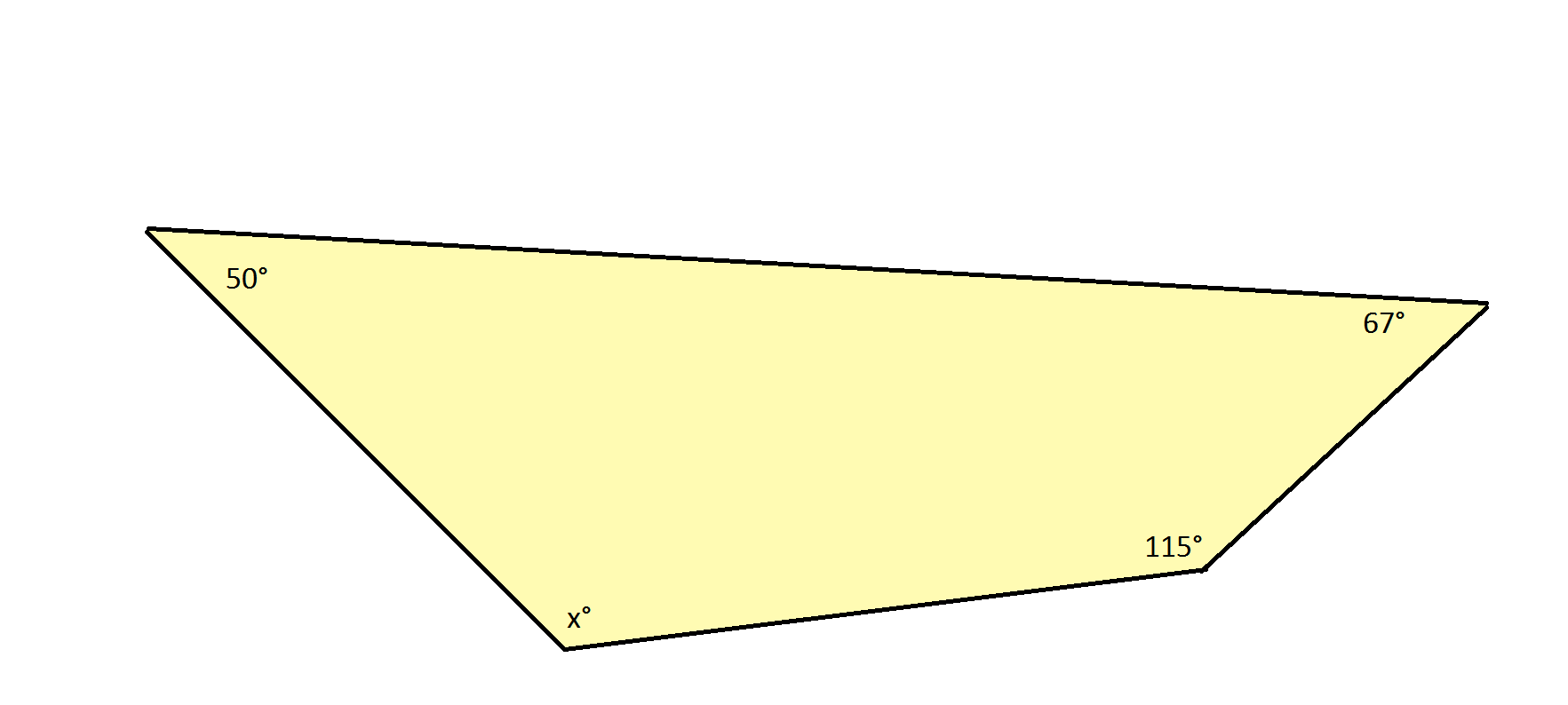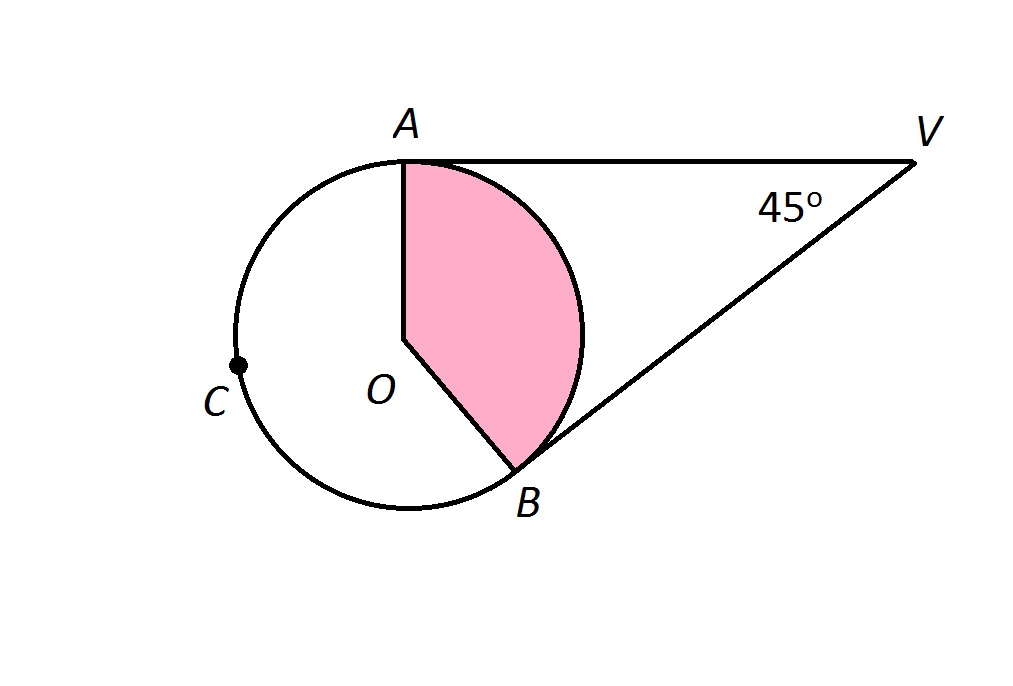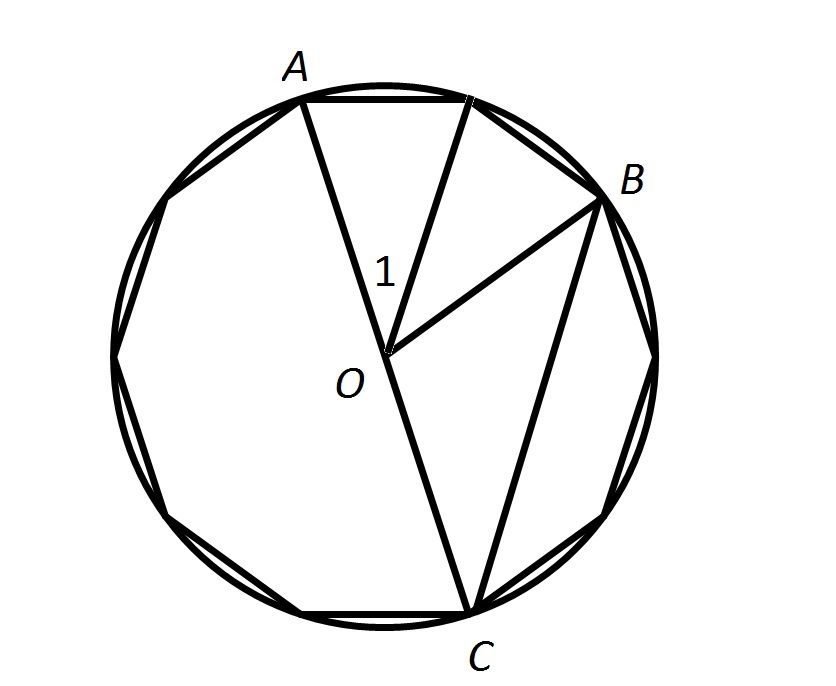Angle measure, central angles, and inscribed angles - HiSet: High School Equivalency Test: Math
Card 0 of 11

A quadrilateral is shown, and the angle measures of 3 interior angles are given. Find x, the missing angle measure.

A quadrilateral is shown, and the angle measures of 3 interior angles are given. Find x, the missing angle measure.
The sum of the measures of the interior angles of a quadrilateral is 360 degrees. The sum of the measures of the interior angles of any polygon can be determined using the following formula:
 , where
, where  is the number of sides.
is the number of sides.
For example, with a quadrilateral, which has 4 sides, you obtain the following calculation:

Solving for  requires setting up an algebraic equation, adding all 4 angles to equal 360 degrees:
requires setting up an algebraic equation, adding all 4 angles to equal 360 degrees:

Solving for  is straightforward: subtract the values of the 3 known angles from both sides:
is straightforward: subtract the values of the 3 known angles from both sides:


The sum of the measures of the interior angles of a quadrilateral is 360 degrees. The sum of the measures of the interior angles of any polygon can be determined using the following formula:


For example, with a quadrilateral, which has 4 sides, you obtain the following calculation:
Solving for 
Solving for 
Compare your answer with the correct one above

 is the center of the above circle. Calculate
is the center of the above circle. Calculate  .
.



 is the central angle that intercepts
is the central angle that intercepts  , so
, so
 .
.
Therefore, we need to find  to obtain our answer.
to obtain our answer.
If the sides of an angle with vertex outside the circle are both tangent to the circle, the angle formed is half the difference of the measures of the arcs. Therefore,

Letting  , since the total arc measure of a circle is 360 degrees,
, since the total arc measure of a circle is 360 degrees,

We are also given that

Making substitutions, and solving for  :
:


Multiply both sides by 2:


Subtract 360 from both sides:


Divide both sides by  :
:

 ,
,
the measure of  and, consequently, that of
and, consequently, that of  .
.



Therefore, we need to find 
If the sides of an angle with vertex outside the circle are both tangent to the circle, the angle formed is half the difference of the measures of the arcs. Therefore,
Letting 
We are also given that
Making substitutions, and solving for 
Multiply both sides by 2:
Subtract 360 from both sides:
Divide both sides by 

the measure of 

Compare your answer with the correct one above

The above figure shows a regular seven-sided polygon, or heptagon, inscribed inside a circle.  is the common center of the figures.
is the common center of the figures.
Give the measure of  .
.

The above figure shows a regular seven-sided polygon, or heptagon, inscribed inside a circle. 
Give the measure of 
Consider the figure below, which adds some radii of the heptagon (and circle):

 , as a radius of a regular polygon, bisects
, as a radius of a regular polygon, bisects  . The measure of this angle can be calculated using the formula
. The measure of this angle can be calculated using the formula
 ,
,
where  :
:

Consequently,
 ,
,
the correct response.
Consider the figure below, which adds some radii of the heptagon (and circle):




where 
Consequently,

the correct response.
Compare your answer with the correct one above

The above figure shows a regular seven-sided polygon, or heptagon, inscribed inside a circle.  is the common center of the figures.
is the common center of the figures.
Give the measure of  .
.

The above figure shows a regular seven-sided polygon, or heptagon, inscribed inside a circle. 
Give the measure of 
Examine the diagram below, which divides  into three congruent angles, one of which is
into three congruent angles, one of which is  :
:

The measure of a central angle of a regular  -sided polygon which intercepts one side of the polygon is
-sided polygon which intercepts one side of the polygon is  ; setting
; setting  , the measure of
, the measure of  is
is
 .
.  has measure three times this; that is,
has measure three times this; that is,

Examine the diagram below, which divides 


The measure of a central angle of a regular 





Compare your answer with the correct one above

The above figure shows a regular seven-sided polygon, or heptagon, inscribed inside a circle.  is the common center of the figures.
is the common center of the figures.
Give the measure of  .
.

The above figure shows a regular seven-sided polygon, or heptagon, inscribed inside a circle. 
Give the measure of 
Examine the diagram below, which divides  into two congruent angles, one of which is
into two congruent angles, one of which is  :
:

The measure of a central angle of a regular  -sided polygon which intercepts one side of the polygon is
-sided polygon which intercepts one side of the polygon is  ; setting
; setting  , the measure of
, the measure of  is
is
 .
.  has measure twice this; that is,
has measure twice this; that is,

Examine the diagram below, which divides 


The measure of a central angle of a regular 





Compare your answer with the correct one above

The above figure shows a regular ten-sided polygon, or decagon, inscribed inside a circle.  is the common center of the figures.
is the common center of the figures.
Give the measure of  .
.

The above figure shows a regular ten-sided polygon, or decagon, inscribed inside a circle. 
Give the measure of 
Examine the diagram below, which divides  into two congruent angles, one of which is
into two congruent angles, one of which is  :
:

The measure of a central angle of a regular  -sided polygon which intercepts one side of the polygon is
-sided polygon which intercepts one side of the polygon is  ; setting
; setting  , the measure of
, the measure of  is
is
 .
.  has measure twice this; that is,
has measure twice this; that is,
 .
.
Examine the diagram below, which divides 


The measure of a central angle of a regular 






Compare your answer with the correct one above

The above figure shows a regular ten-sided polygon, or decagon, inscribed inside a circle.  is the common center of the figures.
is the common center of the figures.
Give the measure of  .
.

The above figure shows a regular ten-sided polygon, or decagon, inscribed inside a circle. 
Give the measure of 
Consider the triangle  . Since
. Since  and
and  are radii, they are congruent, and by the Isosceles Triangle Theorem,
are radii, they are congruent, and by the Isosceles Triangle Theorem,  .
.
Now, examine the figure below, which divides  into three congruent angles, one of which is
into three congruent angles, one of which is  :
:

The measure of a central angle of a regular  -sided polygon which intercepts one side of the polygon is
-sided polygon which intercepts one side of the polygon is  ; setting
; setting  , the measure of
, the measure of  is
is
 .
.  has measure three times this; that is,
has measure three times this; that is,
 .
.
The measures of the interior angles of a triangle total  , so
, so

Substituting 108 for  and
and  for
for  :
:






Consider the triangle 



Now, examine the figure below, which divides 


The measure of a central angle of a regular 






The measures of the interior angles of a triangle total 
Substituting 108 for 


Compare your answer with the correct one above

The above figure shows a regular ten-sided polygon, or decagon, inscribed inside a circle.  is the common center of the figures.
is the common center of the figures.
Give the measure of  .
.

The above figure shows a regular ten-sided polygon, or decagon, inscribed inside a circle. 
Give the measure of 
Through symmetry, it can be seen that Quadrilateral  is a trapezoid, such that
is a trapezoid, such that  . By the Same-Side Interior Angle Theorem,
. By the Same-Side Interior Angle Theorem,  and
and  are supplementary - that is,
are supplementary - that is,
 .
.
The measure of  can be calculated using the formula
can be calculated using the formula
 ,
,
where  :
:

Substituting:



Through symmetry, it can be seen that Quadrilateral 




The measure of 

where 
Substituting:
Compare your answer with the correct one above
If two angles are supplementary and one angle measures  , what is the measurement of the second angle?
, what is the measurement of the second angle?
If two angles are supplementary and one angle measures 
Step 1: Define supplementary angles. Supplementary angles are two angles whose sum is  .
.
Step 2: Find the other angle by subtracting the given angle from the maximum sum of the two angles.
So, 
The missing angle (or second angle) is 
Step 1: Define supplementary angles. Supplementary angles are two angles whose sum is 
Step 2: Find the other angle by subtracting the given angle from the maximum sum of the two angles.
So,
The missing angle (or second angle) is
Compare your answer with the correct one above
 and
and  are complementary angles.
are complementary angles.
 and
and  are supplementary angles.
are supplementary angles.


Evaluate  .
.




Evaluate 
 and
and  are supplementary angles, so, by definition,
are supplementary angles, so, by definition,

 , so substitute and solve for
, so substitute and solve for  :
:



 and
and  are complementary angles, so, by definition,
are complementary angles, so, by definition,

Substitute and solve for  :
:



 - that is, the angles have the same measure. Therefore,
- that is, the angles have the same measure. Therefore,
 .
.






Substitute and solve for 


Compare your answer with the correct one above
 and
and  are a pair of vertical angles.
are a pair of vertical angles.
 and
and  are a linear pair.
are a linear pair.
 and
and  are the two acute angles of a right triangle.
are the two acute angles of a right triangle.
Which of the following must be true?






Which of the following must be true?
 and
and  are a pair of vertical angles; it follows that
are a pair of vertical angles; it follows that

 and
and  are a linear pair; it follows that they are supplementary - that is,
are a linear pair; it follows that they are supplementary - that is,
 .
.
 and
and  are the two acute angles of a right triangle; it follows that they are complementary - that is,
are the two acute angles of a right triangle; it follows that they are complementary - that is,
 .
.
Therefore, we have the three statements



From the second statement, we can subtract  from both sides to get
from both sides to get


Substitute this expression for  in the third expression to get
in the third expression to get

Substitute  for
for  :
:

Add  to both sides:
to both sides:

 ,
,
or, rearranged,
 .
.








Therefore, we have the three statements
From the second statement, we can subtract 
Substitute this expression for 
Substitute 

Add 

or, rearranged,

Compare your answer with the correct one above













































